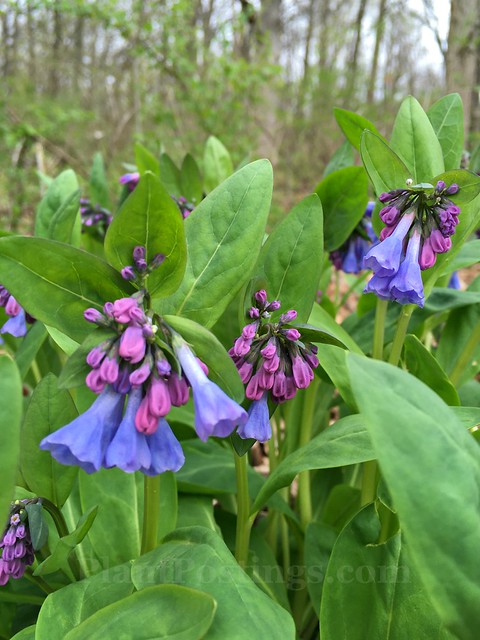
Last week, during a hike at a favorite local state park, I noticed a beautiful patch of Virginia Bluebells (Mertensia virginica). This plant is native to most of Eastern North America and is beloved by many ... gardeners and nature-lovers, alike. This little patch I discovered was noteworthy, both because of its beauty and because it was the only patch I saw that day after hiking in a large area.
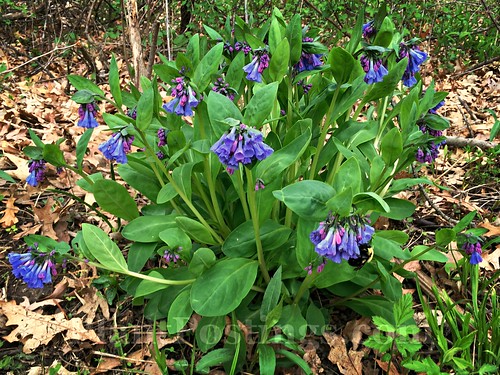
Based on my own experience with Virginia Bluebells, I immediately formed a hypothesis. This patch was near the parking lot. Could it be that Mertensia has trouble establishing elsewhere in the park because of rabbits? Perhaps the rabbits tend to shy away from the busy parking lot area.

My theory was based on many years of trying to get Virginia Bluebells established in my own garden. I do have several patches still growing at home--plants I started from seed several years ago. But the one year they did bloom, the rabbits chewed them to bits just as they were blooming. This year, I don't see any buds, for some reason, although I've caged the plants from the bunnies.
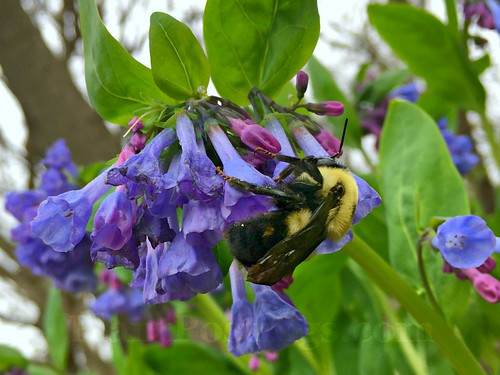
In any case, if you DON'T have a rabbit problem or you have a protected area in your garden, Mertensia virginica is an excellent plant to support native bumble bees. The plant blooms just as the queens are getting active in the spring and looking for early pollen and nectar sources. On this beautiful patch at the state park, I observed a resting queen.
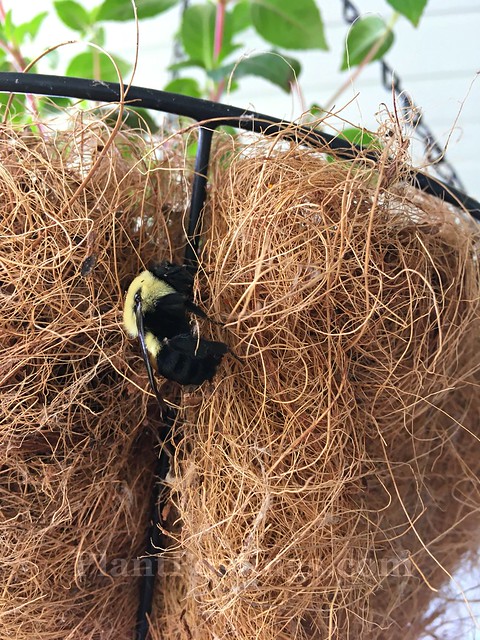
I've noticed many lethargic queens lately, during walks around the block and resting in unusual locations.

Like this one in a dangerous spot on the front porch. I don't usually interfere with nature, but I very carefully lifted her with a piece of light cardboard and placed her near some blooming flowers. I'm a little worried about the bumble bee queens this spring, because of how cool our weather has been lately, with at least one frost/freeze in the forecast this week. Blooming plants are still rather scarce.
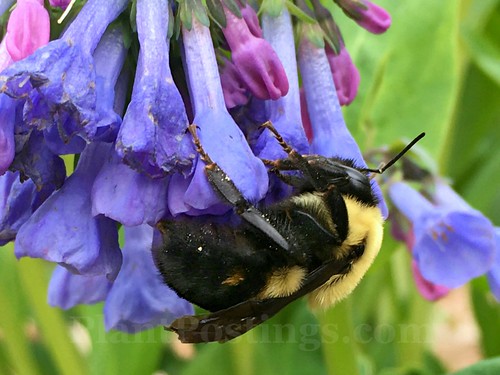
The Xerces Society for Invertebrate Conservation recently published this excellent article on Five Ways to Support Queen Bumble Bees. Native plants like Virginia Bluebells definitely play an important role--one of many reasons these beautiful blooms are worth protecting from hungry bunnies.
Rabbits are my nemesis in the garden. UGH... Gorgeous photos Beth.
ReplyDeleteThanks, Lisa. I so agree. I have a horrible rabbit overpopulation. Just enough great, safe habitat for rabbits and not enough natural predators. With that said, we HAVE seen some Coopers hawks lately, and some rabbit "parts." Still, I have to cage anything that rabbits like to eat.
DeleteBut, interesting to create habitat for hawks. So long as I don't happen to see the blood and guts moment. Trees and birds slowly draw raptors to visit my garden. One I have seen, and sometimes hear owls.
DeleteFabulous photos! And such good news. I always thought Virginia bluebells didn't grow in our part of the world.
ReplyDeleteThank you, Pat. They are beautiful flowers, and I'm so glad I occasionally have a chance to see them. :)
DeleteGreat theory as to why the one patch survived. Rabbits, they are very cute and fun to watch, but destructive in the garden. We have quite a few this year but they seem to be staying away from the house. Scooter likes to chase them. It makes him feel important.
ReplyDeleteJeannie@GetMeToTheCountry
Ha! My dog always wants to chase them, too, but he's still a young guy and I always have him on a leash. I'm not sure I'd want him to bring me back a rabbit, anyway. ;-)
DeleteReally great set of shots, Beth. I especially like the close ups of your bumbles. I see bumble bees, but usually a little later in the season. They make their presence known.
ReplyDeleteAs for the rabbits, they're around here in Austin, but have never been a problem for me. I guess I'm lucky.
Thank you, Tina. There are so many active bumble bee queens around here right now. It's pretty obvious they're queens early in the season, for us, because our winters are so harsh...only the new queens overwinter and emerge in the early spring, collect pollen and nectar for their nests, and then lay eggs from mating the previous fall. You are lucky that you don't have a rabbit problem!
DeleteHmm. Your comments made me realize that, while I've seen plenty of bees, I don't recall seeing any bumble bees as yet. Cold weather can't be a factor here, though.
ReplyDeleteThat's interesting, Kris. I wonder how your bumble bee cycle is different from ours. You have a mild climate, while our winters are harsh. I certainly am not a bumble bee expert, but your comment has me curious about California bumble bees!
DeleteI am always impressed at how much you think through what you see to try to understand what it means and what is causing it.
ReplyDeleteThank you, Linda. It must be the journalist's (and naturalist's) mindset? I know you are inquisitive, too, based on your profession. :) Turns out, perhaps the cause was partially rabbits, but I went back to the state park today, and sadly it's carpeted with garlic mustard. Terrible competition for native woodland wildflowers. :(
DeleteThanks for the link - very useful. After my experience with tulips this year, I'm thinking I may try to surround my VA bluebell patches with narcissi this fall. Of course that requires remembering where all the bluebells are.
ReplyDeleteYou're welcome! Good idea! I planted native Alliums around my Bluebells, but they're later-emerging. So, I think I'm going to have to try something else. I was trying to keep that area of the "garden" native plants. Most of the plants back there are naturally occurring, except for the VA Bluebells.
DeleteHappy Mother's Day Beth,
ReplyDeleteThank you for sharing with us. We saw a few bumble bees on our hike the other day. It has gotten so cold here, oh my! Hope everything can hang on until our warm up on Wednesday.
Thanks, Carla; back at ya. ;-) Yes! I'm so glad to have all that frigid weather behind us. It looks pretty good from here on out. Yay!
DeleteInteresting article from Xerces. I'm all for leaving dandelions and leaves!
ReplyDeleteI thought so, too. We use corn gluten meal to reduce the dandelions, but no poisons on the lawn! So there are always a few dandelions remaining. And I rake the leaves into the garden beds and into the woods. :)
DeleteThe blue flower is so beautiful! I like blue flower.
ReplyDeleteIt's such a beautiful shade of blue, isn't it? :)
ReplyDeleteBlue bells are a bit of a weed in our shady gardens, and they are not limited by bunnies at all. You would probably be shocked by how many bluebells get pulled up and discarded to keep things a bit balanced. Yes, I've seen quite a few carpenter bees, often visiting bluebells, but as nectar robbers rather than pollinators.
ReplyDeleteBeautiful photos! Interesting information.
ReplyDeleteHave a wonderful weekend!